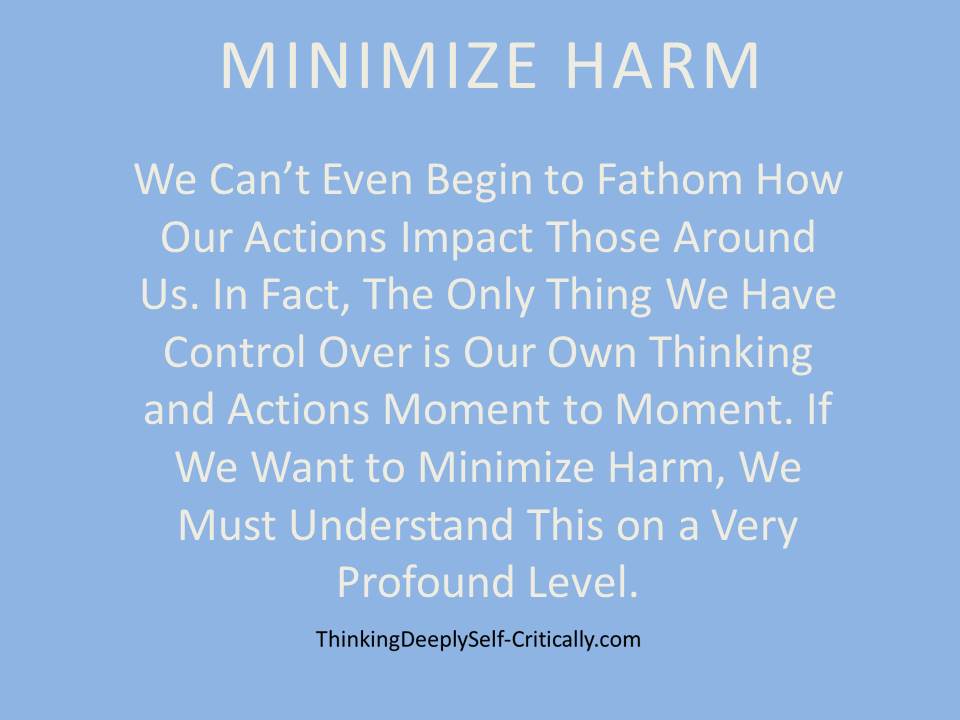6 Best Ways to Minimize Harm
In the counseling field there is an old saying “do no harm.” I have heard this from the beginning of my career, and I have come to realization this is one of the hardest concepts to achieve. We can’t even begin to fathom how our actions impact those around us. In fact, the only thing we have control over is our own thinking and actions moment to moment. If we want to minimize harm, we must understand this on a profound level.
Every single thought we entertain possesses the potential to influence others profoundly. It is remarkable how just a single thought can set us on a path of causing harm. Thus, it becomes vital to approach our thoughts with intention and productivity, ensuring we minimize any potential harm. Developing acute mindfulness of our thinking process enables us to swiftly halt counterproductive thoughts, leading us to achieve optimal outcomes. Ultimately, maintaining control over our thoughts becomes imperative in our quest to mitigate the risks of causing harm to others.
1 Minimizing harm takes purposeful interventions.
Interventions aren’t about shooting the breeze with others. There about maintaining a healthy relationship. In the counseling field it’s about maintain a therapeutic relationship. Interventions should include clear boundaries when necessary and tactful behaviors that cultivate connection. Purposeful interventions need to show that you’re interested in what is going on. They need to be driven with warm positive regard and genuine care and concern.
2 Minimizing harm takes being aware of your body language
Our body behaviors show the other person if we are invested in them. Furthermore, it also shows people when we don’t care. Our body language needs to be purposeful and demonstrate engagement. We need to constantly consider what message our body is sending others. The slightest mishap could create a condition of harm. In the moment, if we feel what we have just demonstrated with our body language was harmful we need to make it right. We can simply do this by being transparent and honest. “I just came aware that my body language communicated that I didn’t. I hope you don’t mind if I try again.”
3 Constantly Instill Hope
People are fragile and harm is easy to do. We can do our part helping to repair the damage we see. One way we can do this is by instilling hope. Not just one or two times in the situation but constantly with our approach. If we are purposeful enough, we can instill hope in every aspect of the interaction (how we talk, listen and behave). Instilling hope in an art and if we have enough compassion for the situation, we can become fluent with it.
4 Always search for clarity
Harm is a result of physical or mental damage. To get to the point of harm there was a lack of clarity somewhere in the process or situation. We may not be able to find all the missing clarity but it’s important to continue to search for clarity to minimize harm. Seeking for clarity creates a condition of competence about the situation. Furthermore, its followed by a deeper understanding and ultimately results in compassion. So, always go back to seeking clarity when what is happening in front of you is unclear.
5 Continually be mindful
To get a non-bias judgment about a situation it’s probably safe to assume what we are thinking about the situation is wrong. Mindfulness will help us minimize harm. It will help us consider the possibilities that we haven’t through about yet. Mindfulness gives us new direction and really helps us look at the bigger picture. The complicated part is stepping outside of what we think/believe is the truth and put ourselves into other’s truths.
6 Create Conditions that are empowering
Empowering those around us helps minimize harm. We have a responsibility to others to create opportunities for them to be successful. We can do this by creating conditions in ourselves and in the environment around us. Creating conditions is a concept which is about continually learning, adapting, and seeking deeper understanding that everything you think and do has a profound impact on others around you. If you would like more information on creating conditions, please check on the article on the website.
Conclusion
Doing no harm it a great concept and we should always strive to do this. Furthermore, we can’t even fathom the harm that has already been done and some harm may be beyond repair. Sometimes situations are so profoundly complex that the only thing we can do is figure out how to minimize the harm we are doing. When get to a situation and begin to move forward we must always start with doing no harm. Minimizing harm helps us cultivate meaningful relationships with other and helps us to become the best version of us by serving others.
If you like what you have read, check out other articles on the website ThinkingDeeplySelf-Critically.com the site is designed to give us tools and techniques to help us become the best version of ourselves. There are four main categories on the site. The Foundation, Our Responsibility to Us, Our Responsibility to Others and Facilitating Crisis. We can also be found on Pinterest.


